The Sandy Bridge Review: Intel Core i7-2600K, i5-2500K and Core i3-2100 Tested
by Anand Lal Shimpi on January 3, 2011 12:01 AM ESTThe 6-series Platform
At launch Intel is offering two chipset families for Sandy Bridge: P-series and H-series, just like with Lynnfield. The high level differentiation is easy to understand: P-series doesn’t support processor graphics, H-series does.
There are other differences as well. The P67 chipset supports 2x8 CrossFire and SLI while H67 only supports a single x16 slot off of the SNB CPU (the chip has 16 PCIe 2.0 lanes that stem from it).
While H67 allows for memory and graphics overclocking, it doesn’t support any amount of processor overclocking. If you want to overclock your Sandy Bridge, you need a P67 motherboard.
6Gbps
Had SSDs not arrived when they did, I wouldn’t have cared about faster SATA speeds. That’s how it worked after all in the evolution of the hard drive. We’d get a faster ATA or SATA protocol, and nothing would really change. Sure we’d eventually get a drive that could take advantage of more bandwidth, but it was a sluggish evolution that just wasn’t exciting.
SSDs definitely changed all of that. Today there’s only a single 6Gbps consumer SSD on the market—Crucial’s RealSSD C300. By the middle of the year we’ll have at least two more high-end offerings, including SandForce’s SF-2000. All of these SSDs will be able to fully saturate a 3Gbps SATA interface in real world scenarios.
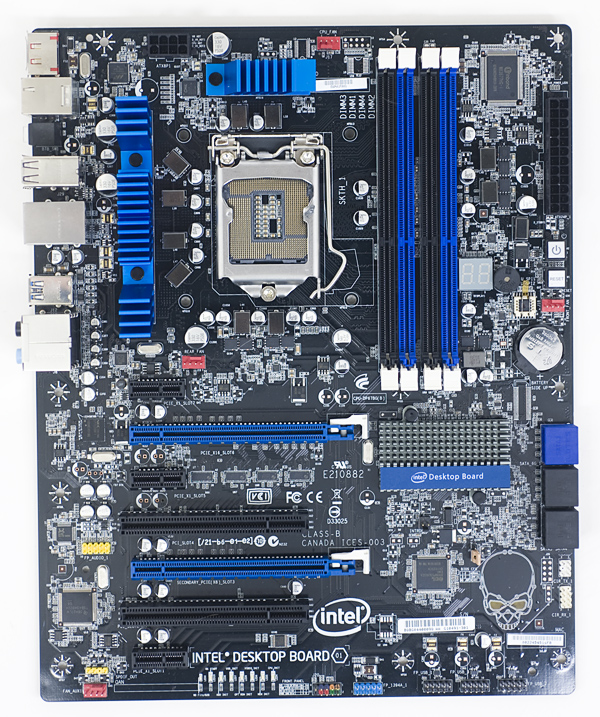
Intel's DP67BG—The blue SATA ports on the right are 6Gbps, the black ones are 3Gbps
To meet the soon to be growing need for 6Gbps SATA ports Intel outfits the 6-series PCH with two 6Gbps SATA ports in addition to its four 3Gbps SATA ports.
I dusted off my 128GB RealSSD C300 and ran it through a bunch of tests on five different platforms: Intel’s X58 (3Gbps), Intel’s P67 (3Gbps and 6Gbps), AMD’s 890GX (6Gbps) and Intel’s X58 with a Marvell 9128 6Gbps SATA controller. The Marvell 91xx controller is what you’ll find on most 5-series motherboards with 6Gbps SATA support.
I ran sequential read/write and random read/write tests, at a queue depth of 32 to really stress the limits of each chipset’s SATA protocol implementation. I ran the sequential tests for a minute straight and the random tests for three minutes. I tested a multitude of block sizes ranging from 512-bytes all the way up to 32KB. All transfers were 4KB aligned to simulate access in a modern OS. Each benchmark started at LBA 0 and was allowed to use the entire LBA space for accesses. The SSD was TRIMed between runs involving writes.
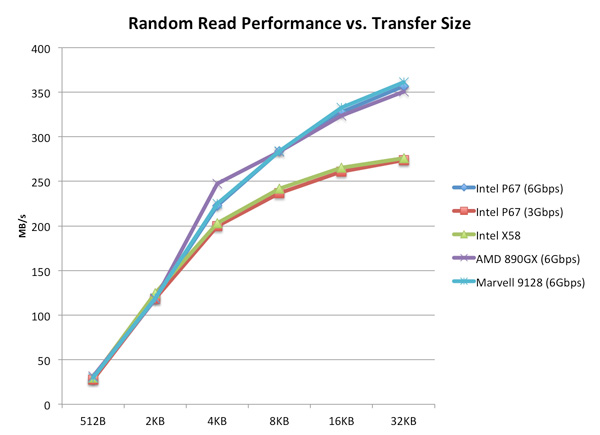
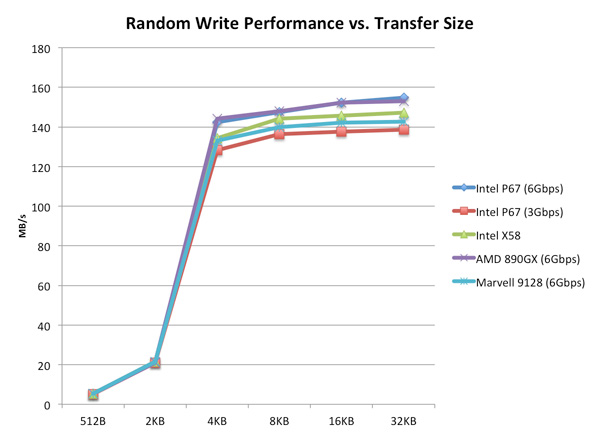
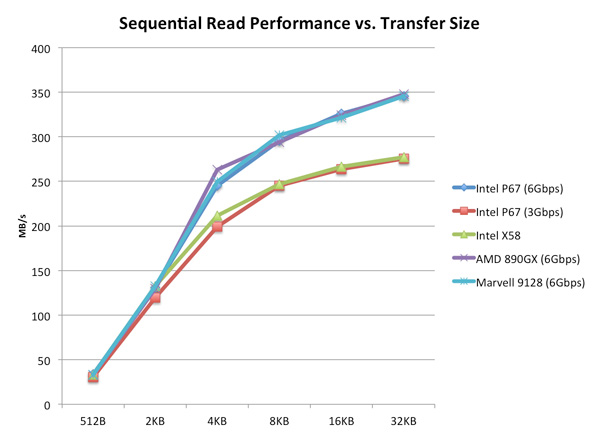
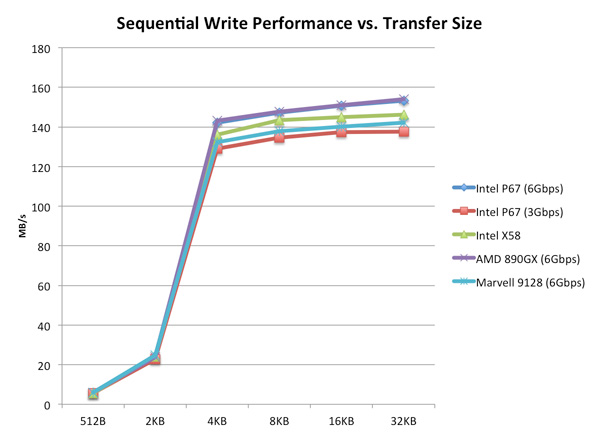
Among Intel chipsets I found that the X58 has stellar 3Gbps SATA performance, which is why I standardize on it for my SSD testbed. Even compared to the new 6-series platform there are slight advantages at high queue depths to the X58 vs. Intel’s latest chipsets.
Looking at 6Gbps performance though there’s no comparison, the X58 is dated in this respect. Thankfully all of the contenders do well in our 6Gbps tests. AMD’s 8-series platform is a bit faster at certain block sizes but for the most part it, Intel’s 6-series and Marvell’s 91xx controllers perform identically.
I hate to be a bore but when it comes to SATA controllers an uneventful experience is probably the best you can hope for.


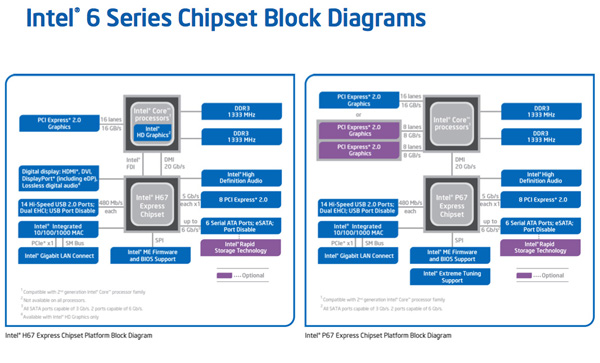








283 Comments
View All Comments
aviat72 - Tuesday, January 4, 2011 - link
Though SB will be great for some applications, there are still rough edges in terms of the overall platform. I think it will be best to wait for SNB-E or at least the Z68. SNB-E seems to be the best future-proofing bet.I also wonder how a part rated for 95W TDP was drawing 111W in the 4.4GHz OC (the Power Consumption Page). SB's power budget controller must be really smart to allow the higher performance without throttling down, assuming your cooling system can manage the thermals.
marraco - Tuesday, January 4, 2011 - link
I wish to know more about this Sandy Bridge "feature":http://www.theinquirer.net/inquirer/news/1934536/i...
PeterO - Tuesday, January 4, 2011 - link
Anand, Thanks for the great schooling and deep test results -- something surely representing an enormous amount of time to write, produce, and massage within Intel's bumped-forward official announcement date.Here's a crazy work-around question:
Can I have my Quick Synch cake and eat my Single-monitor-with-Discrete-Graphics-card too if I, say:
1). set my discrete card output to mirror Sandy Bridge's IGP display output;
2). and, (should something exist), add some kind of signal loopback adapter to the IGP port to spoof the presence of a monitor? A null modem, of sorts?
-- I have absolutely no mobo/video signaling background, so my idea may be laugh in my face funny to anybody who does but I figure it's worth a post, if only for your entertainment. :)
Hrel - Wednesday, January 5, 2011 - link
It makes me SO angry when Intel does stupid shit like disable HT on most of their CPU's even though the damn CPU already has it on it, they already paid for. It literally wouldn't cost them ANYTHING to turn HT on those CPU's yet the greedy bastards don't do it.Moizy - Wednesday, January 5, 2011 - link
The HD Graphics 3000 performance is pretty impressive, but won't be utilized by most. Most who utilize Intel desktop graphics will be using the HD Graphics 2000, which is okay, but I ran back to the AMD Brazos performance review to get some comparisons.In Modern Warfare 2, at 1024 x 768, the new Intel HD Graphics 2000 in the Core i3 2100 barely bests the E-350. Hmm--that's when it's coupled with a full-powered, hyper-threaded desktop compute core that would run circles around the compute side of the Brazos E-350, an 18w, ultra-thin chip.
This either makes Intel's graphics less impressive, or AMD's more impressive. For me, I'm more impressed with the graphics power in the 18w Brazos chip, and I'm very excited by what mainstream Llano desktop chips (65w - 95w) will bring, graphics-wise. Should be the perfect HTPC solution, all on the CPU (ahem, APU, I mean).
I'm very impressed with Intel's video transcoding, however. Makes CUDA seem...less impressive, like a bunch of whoop-la. Scary what Intel can do when it decides that it cares about doing it.
andywuwei - Wednesday, January 5, 2011 - link
not sure if anybody else noticed. CPU temp of the i5@3.2GHz is ~140 degrees. any idea why it is so high?SantaAna12 - Wednesday, January 5, 2011 - link
Did I miss the part where you tell of about the DRM built into this chip?Cb422 - Wednesday, January 5, 2011 - link
When will Sandy Bridge be available on Newegg or Amazon for me to purchase?DesktopMan - Thursday, January 6, 2011 - link
Very disappointed in the lack of vt-d and txt on k-variants. They are after all the high end products. I also find the fact that only the k-variants having the faster GPU very peculiar, as those are the CPUs most likely to be paired with a discrete GPU.RagingDragon - Thursday, January 6, 2011 - link
Agreed. I find the exclusion of VT-d particularly irritating: many of the overclockers and enthusiasts to whom the K chips are marketed also use virtualization. Though I don't expect many enthusiasts, if any, to miss TXT (it's more for locked down corporate systems, media appliances, game consoles, etc.).With the Z68 chipset coming in the indeterminate near future, the faster GPU on K chips would have made sense if the K chips came with every other feature enabled (i.e. if they were the "do eveything chips").
Also, I'd like to have the Sandy Bridge video encode/decode features separate from the GPU functionality - i.e. I'd like to choose between Intel and Nvidia/AMD video decode/encode when using a discrete GPU.